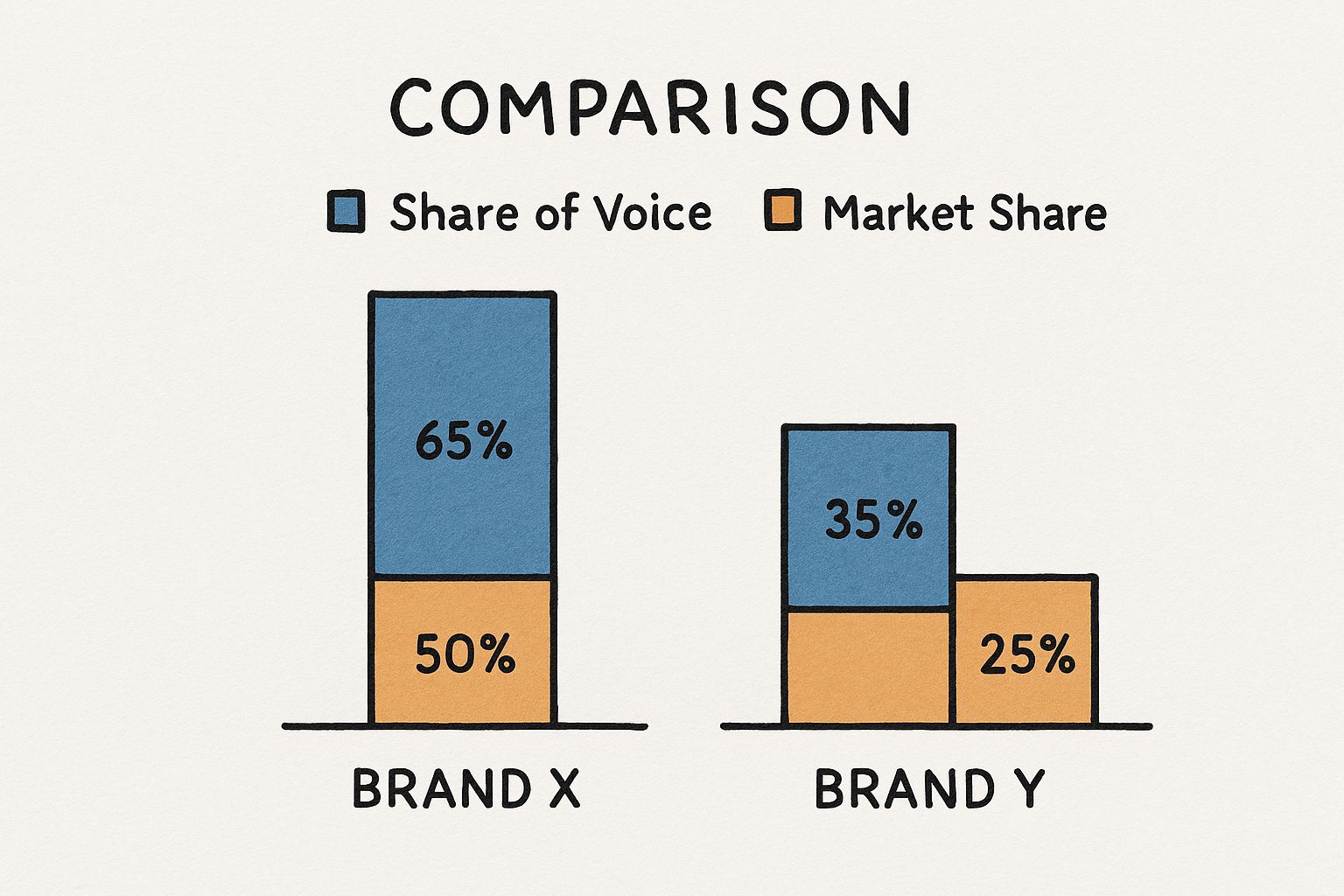If your brand isn’t being talked about, it might as well be invisible. That’s where Share of Voice (SOV) comes in. It’s the metric that cuts through the noise and tells you exactly how much of the conversation in your market you actually own.
Think of it as your slice of the pie—the entire pie being every mention, ad, and discussion happening in your industry.
Most guides on this topic are vague. They talk about "brand awareness" but don't give you a clear path from measurement to market share. This guide is different. We'll show you how to measure SOV without a data team and use it to outsmart, not outspend, your competition.
Why Your Brand's Volume Is Probably Muted
Picture your industry as a massive, crowded room. Every brand, including yours, is trying to get the attention of the same customers. Some brands are whispering. Others are talking. A select few are shouting and being heard above everyone else.
Your share of voice is simply how loud you are in that room.
It’s not just about how much you spend on ads; it’s about how much of the total conversation you command. If you're not being heard, you can't win new customers. Period.
The real goal is to dominate the conversations that matter, on every single channel your customers are using.
From Ad Spend to Attention Span
Back in the day, share of voice was a simple ad spend calculation. If the total ad spend in the auto industry was $1 billion and Ford spent $50 million, their SOV was 5%. It was a solid predictor of growth. Long-standing benchmarks showed that brands with an SOV just 10 points higher than their market share could expect to grow by 0.5% annually. You can read more about the origins of this metric.
But today, that "room" is infinitely more complex. The conversation is happening everywhere, all at once.
- Organic Search: How often do you show up for the top keywords compared to your competitors?
- Social Media: What percentage of the mentions, hashtags, and discussions are actually about you?
- Paid Media: What’s your impression share on Google Ads or paid social?
- PR and News: Are media outlets talking about you, or someone else?
The modern definition of share of voice is your brand's total visibility across all relevant channels compared to your competitors. It's a direct reflection of your brand's presence in a customer's world.
Your Voice Predicts Your Future Growth
It’s simple: a higher share of voice almost always leads to a higher market share. When customers see and hear your brand more often than the competition, they start to see you as the leader. You become the default choice.
This infographic breaks it down perfectly, showing the direct link between owning the conversation and owning the market.

The data doesn’t lie. The brand that commands more of the conversation also commands more of the market. This leads to the golden rule of growth: maintain a share of voice that is greater than your current market share.
Your brand’s volume today directly fuels its revenue tomorrow.
How to Calculate Share of Voice Without a Data Team

Calculating share of voice isn't just for mega-brands. The conversation isn't just on TV or radio; it’s scattered across a dozen different channels, making the whole calculation feel complicated.
The good news? You don't need a massive data science team to figure this out.
The key is to stop trying to measure everything at once. Break it down channel by channel. The basic formula never changes.
Share of Voice (SOV) % = (Your Brand's Metric / Total Market Metric) x 100
What's different is the metric you plug in. You just need to swap it out depending on where you're measuring your presence.
Measuring SOV in Organic Search
For organic search, it’s all about visibility. Forget ad spend—this is about how often you show up when potential customers are actively looking for solutions. Think of it as owning the digital shelf space on Google.
- Your Brand's Metric: Your total impressions for a target keyword list.
- Total Market Metric: The total impressions for all competitors ranking for the same list.
Tools like Semrush let you set up projects, plug in your most important keywords, and see exactly how your visibility compares to direct competitors. A crucial first step is understanding how to calculate impressions, since this data is the foundation of your analysis.
Calculating SOV in Paid Search
Paid search is more direct because the ad platforms do the heavy lifting. The magic metric here is Impression Share. Both Google Ads and Microsoft Ads tell you what percentage of all possible ad impressions your campaigns received.
- Your Brand's Metric: Your Impression Share percentage.
- Total Market Metric: This is already baked in; 100% represents the entire ad market for your keywords.
If Google Ads reports a 40% Impression Share, your SOV for those paid keywords is 40%. You're showing up in four out of every ten available ad slots. It’s one of the most straightforward ways to measure your paid share of voice in advertising.
Tracking SOV on Social Media
Social media is a conversation. Your metric needs to reflect that. Here, you'll be tracking mentions—of your brand, products, and campaign-specific hashtags. This is where your earned media really comes into play.
- Your Brand's Metric: The total number of mentions of your brand, products, or hashtags.
- Total Market Metric: The total number of mentions for your brand plus all of your competitors.
Social listening tools are essential here. Platforms like Brandwatch can monitor conversations across multiple social networks, automatically tallying up mentions and giving you a clear SOV percentage.
SOV Is a Multi-Channel Metric
Digital media rewired this metric. It's no longer just about who has the biggest ad budget. Search engines and social media turned share of voice into a complex indicator that covers paid, owned, and earned channels all at once. For a deeper look, check out this guide on how to calculate share of voice across every platform.
To help you get started, the table below breaks down the best approach for each channel.
Modern Share of Voice Calculation Methods by Channel
This table breaks down how to calculate SOV across different modern advertising channels, including the specific metrics to track and recommended tools for measurement.
| Channel | Primary Metric to Track | Calculation Formula | Recommended Tools |
|---|---|---|---|
| Organic Search | Keyword Impressions | (Your Impressions / Total Market Impressions) x 100 | Semrush, Ahrefs |
| Paid Search | Impression Share | (Your Impressions / Total Possible Impressions) x 100 | Google Ads, Microsoft Ads |
| Social Media | Brand/Hashtag Mentions | (Your Mentions / Total Market Mentions) x 100 | Brandwatch, Sprout Social |
| PR & Media | Media Mentions | (Your Mentions / Total Industry Mentions) x 100 | Google Alerts, Cision |
By tackling SOV one channel at a time, you can build a comprehensive view of your brand’s visibility without a dedicated analytics department.
How a High Share of Voice Actually Wins the Market
Having a high share of voice isn't just about bragging rights. It's a direct, measurable path to dominating your market. There's a powerful, proven link between how much you own the conversation and how much of the market you eventually own.
When customers see your brand more than anyone else's, a simple psychological shift happens. They start to see you as the market leader—the default, most trusted option. This constant visibility makes the sales cycle shorter because you're always top of mind.
This connection is so reliable it even has a name: Excess Share of Voice (eSOV).
The Proven Rule of eSOV
The idea behind eSOV is simple: if your share of voice is higher than your market share, your brand will grow. If it's lower, you're likely to shrink. Think of it as investing in your future growth. You're building "mind share" today to capture market share tomorrow.
A brand that maintains an SOV 10 percentage points higher than its market share can expect to grow its market share by about 0.5% per year. That might not sound like much, but it's the recipe for sustained, long-term leadership.
This rule holds true across industries and over decades. It shows that spending on your brand's visibility isn't just an expense; it’s a direct investment in future revenue.
How Visibility Builds a Competitive Moat
Consistently showing up where your customers are does more than just build familiarity. It creates a powerful competitive advantage that’s incredibly tough for others to break.
Here's how a dominant share of voice works for you:
- It Establishes Trust: The more people see your brand, the more they trust it. Psychologists call this the mere-exposure effect. Familiarity breeds comfort.
- It Creates Perceived Leadership: The loudest voice in the room is almost always seen as the leader. This perception becomes a self-fulfilling prophecy.
- It Reduces Acquisition Costs: When your brand is already known and trusted, you don't have to work as hard to convince every single new customer.
Decades of advertising research prove this connection. Data consistently shows that brands with an SOV that stays above their market share tend to grow. You can see a great breakdown of SOV's impact for more detail.
Mini Case Study: How Dollar Shave Club Won the Conversation
Remember when buying razors meant choosing between Gillette and Schick? Dollar Shave Club launched in 2011 with a tiny market share but a brilliant share of voice in advertising strategy. They couldn't outspend the giants on TV ads.
So they didn't. They focused on one channel: YouTube.
Their launch video, "Our Blades Are F***ing Great," cost about $4,500 to make and went viral. It was funny, authentic, and completely different from the sterile, high-tech ads from competitors. The video generated millions of views and massive organic buzz.
For a brief period, Dollar Shave Club's SOV on social media and YouTube was likely higher than the established players. This eSOV strategy paid off. Their brand recall shot through the roof, leading to 12,000 orders in the first 48 hours. By 2016, they had a 5% market share and were acquired by Unilever for $1 billion.
They didn't win everywhere, but they won where it counted.
Real-World Examples of SOV in Action

Theory only gets you so far. The real magic of share of voice in advertising happens when you see how scrappy brands use it to outmaneuver giants.
You don't need a massive budget to win. You just need to own the right conversation.
Let’s break down two different cases where a smart SOV play led to massive wins.
How a B2B Startup Stole the Spotlight with SEO
Picture a small B2B tech startup, "SyncUp," trying to muscle into the project management space. They're up against monsters like Asana and Monday.com, who burn millions on ads without blinking. SyncUp’s entire budget was a rounding error for them.
They couldn't win a spending war. So they changed the battlefield.
Instead of fighting everywhere, they decided to completely dominate the organic search conversation for one tiny, high-value niche: "project management for remote engineering teams."
- Step 1: Find the Niche Keywords. They dug into SEO tools to find the long-tail keywords their ideal customers were actually typing in. Think "asynchronous sprint planning tools" and "Gantt charts for distributed teams." Low search volume, but sky-high purchase intent.
- Step 2: Create 10x Content. They built an entire resource hub with in-depth guides, free templates, and case studies that spoke directly to the headaches of remote engineering managers. Their content was simply better and more specific.
- Step 3: Track Obsessively. They monitored their organic impression share for their target keyword cluster like a hawk. The goal was ambitious: achieve a 75% organic SOV for this niche within nine months.
The result? In under a year, SyncUp was on the first page for nearly all of their target terms. Their organic search SOV in that niche hit 80%. This drove a firehose of qualified leads, bumping demo requests by 40%—all without pouring more money into ads.
By focusing on Share of Search for a specific niche, SyncUp bypassed the spending power of incumbents and established themselves as the go-to authority for a valuable customer segment. This is strategy over budget.
Winning a Product Launch with Social SOV
Now for a totally different arena. A direct-to-consumer (DTC) beauty brand called "Glowry" was launching a new vegan skincare line. The market was a mess of celebrity brands and big-box names. They needed to make a huge splash.
Their entire launch strategy boiled down to one goal: own the social media conversation around the hashtag #CleanBeautyLaunch for one specific week.
Their tactics were surgical and aggressive.
- Micro-Influencer Blitz: They skipped the A-listers and instead partnered with 50 micro-influencers who lived and breathed clean beauty. Each creator got a clear schedule and talking points, creating a concentrated wave of content over just 72 hours.
- Competitor Mention Monitoring: Using social listening tools, they watched competitor mentions in real-time. Anytime someone asked a question on a rival's post, Glowry's team swooped in with helpful, non-salesy advice.
- Hashtag Domination: The coordinated push from the micro-influencers completely flooded the #CleanBeautyLaunch tag. It drowned out the competition and made it feel like Glowry's launch was the only thing happening.
During launch week, Glowry commanded an estimated 90% share of voice for their target hashtag on Instagram. The campaign sparked over 20,000 user-generated posts, and the new product line sold out in just four days.
They proved a focused social SOV assault can generate more real buzz and sales than a spray-and-pray ad campaign. Building a community of advocates is one of the best ways to earn brand trust. For more on this, our guide on building an advocacy program can provide valuable next steps.
Smart Strategies to Increase Your Share of Voice

Knowing your share of voice is like checking the scoreboard. Growing it is how you win the game. You don't need a massive budget to make a lot of noise.
Smart strategy can amplify your brand’s voice way more effectively than just throwing money at ads. A 2023 System1 study found that advertisers who simply stayed on-air during the summer—when competitors often pull back—saw a significant increase in their SOV without spending more.
That proves a critical point: timing and tactics often beat a bigger budget. Here are five strategies that help you punch above your weight.
Dominate a Niche Conversation
Instead of trying to win the conversation around broad, expensive terms, find a specific, high-intent niche and completely own it.
Be the loudest voice in a small, important room rather than a whisper in a stadium.
- What to do: Pinpoint a specific customer pain point your product solves better than anyone. Then, focus all your content, SEO, and community efforts on becoming the definitive resource for that single topic.
- What to avoid: Spreading your efforts too thin across multiple generic keywords. Fighting for "CRM software" is a losing battle for a startup; winning "CRM for independent financial advisors" is achievable.
Create Linkable Assets and Original Research
One of the fastest ways to earn organic mentions is to create something worth talking about. Linkable assets are high-value pieces of content that other websites and journalists actually want to cite and share.
This is how you generate SOV instead of just buying it.
Original research and unique industry reports are perfect for this. When you publish new data, you become the primary source. Every mention of your findings boosts your brand’s visibility.
Example in Action: An HR tech company could survey 500 managers about burnout trends and publish the findings. That single report could generate dozens of backlinks from industry blogs and media outlets, massively boosting their organic SOV.
Focus on Share of Search
Share of Search is a powerful proxy for your total share of voice, and it’s something you can directly influence with strong SEO. When you consistently show up in search results for your market’s key questions, you become the perceived leader.
This is especially critical now that users are turning to AI chatbots for answers. These models pull information from top-ranking search results. Improving your ranking for key terms means you're not just winning on Google; you're also increasing your chances of being cited by AI. A smart approach includes exploring Answer Engine Optimization to ensure your content is structured for AI visibility.
Engage in Competitor Conversations
Your competitors’ social media posts are goldmines of opportunity. Their customers are right there, asking questions and voicing frustrations.
Engaging ethically in these spaces can steal attention.
- What to do: Use social listening tools to monitor competitor mentions. When you spot a customer struggling with a feature your product does better, offer helpful, non-promotional advice. Position yourself as an expert, not a salesperson.
- What to avoid: Aggressively spamming competitor threads with links to your own product. The goal is to be helpful, not parasitic.
Invest in Memorable Creative
In a sea of forgettable ads, a truly creative campaign generates its own momentum. An ad that makes people laugh, think, or feel something is far more likely to be shared organically.
This organic sharing is a form of earned media that multiplies your share of voice in advertising without adding to your media spend. This is a core part of scaling your ad campaigns effectively.
Realistic Example: A small coffee brand can’t outspend Starbucks. But they can create a hilarious series of short video ads for TikTok. If the content hits, the organic shares could give them a temporarily higher SOV on that platform than their giant rival.
Increasing your share of voice isn't about outspending everyone. It's about outsmarting them.
Your 3-Step Share of Voice Action Plan
Information without action is useless. Here's a simple playbook to start winning the conversation in your market. This is how you turn share of voice in advertising from a fuzzy concept into a real growth strategy.
Think of SOV not as a one-time report, but as a continuous health check on your brand’s competitive pulse. It's your best crystal ball for predicting future market share.
- Benchmark Your Position (One Channel First). Pick the single most important channel your customers use. Use a tool to measure your current SOV on just that channel. You can’t figure out where you’re going until you know where you stand.
- Pick One Fight. Don’t try to win everywhere at once. Choose one channel and one competitor to target for SOV growth next quarter. A focused attack has a measurable impact.
- Measure and Adapt. Track your progress. A simple dashboard can show how your efforts are impacting visibility. Using AI visibility metrics software automates this, giving you a clear view of what's working.
Stop being a passive listener in your market’s conversation. It’s time to start leading it.
Common Questions About Share of Voice
Even after breaking down the strategies, a few practical questions always pop up. Getting the nuances right is what separates a vanity metric from a real growth driver.
How Often Should I Measure My Share of Voice?
Match your measurement frequency to your industry's pace of change.
- For stable markets (B2B industrial): A quarterly check-in is usually enough.
- For fast-moving industries (DTC, tech): Track this monthly.
- During a major campaign or product launch: Check weekly, or even daily, to get real-time feedback.
What Is a Good Share of Voice to Aim For?
A "good" share of voice is always relative. If there are only two major players in your market, aiming for 50% SOV is a realistic goal. In a crowded space with 20 competitors, hitting just 10% could make you the leader.
Forget arbitrary numbers. The real goal is to achieve Excess Share of Voice (eSOV).
Your target SOV should be higher than your current market share. If your market share is 5%, your initial goal should be to secure an SOV of 8-10%. This positive gap is the proven formula for growth.
Can a Small Business Compete on Share of Voice?
Absolutely. The secret is to stop trying to win everywhere and instead focus on winning somewhere specific.
A small business can't outspend Coca-Cola globally, but it can absolutely dominate a niche conversation.
Here are three ways to do it:
- Own Niche Keywords: Focus your SEO on highly specific, long-tail phrases that your ideal customers are searching for.
- Dominate Local Search: If you're a local business, pour your energy into owning the conversation in your city or region.
- Master One Social Channel: Find the one social network where your customers hang out the most and aim to become the most visible voice there.
Small businesses win by being smarter, not richer.
Ready to stop guessing and start measuring your brand's true visibility? AI SEO Tracker shows you exactly where you stand in AI-powered search across platforms like ChatGPT and Gemini. See your AI share of voice, pinpoint competitor gaps, and get a clear action plan to own the conversations that drive revenue.

